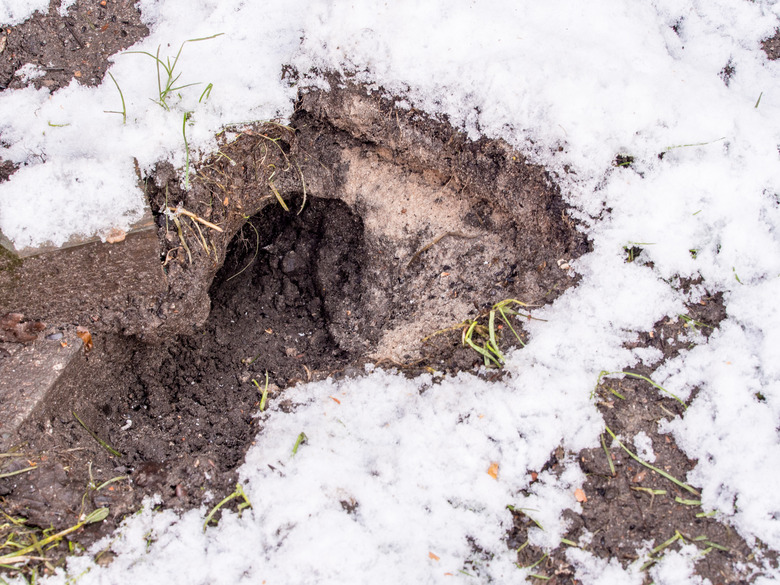How To Remove A Rat Nest
Unless you own one as a pet, rats are always unwelcome visitors in your home, shed or other buildings. But you don't want to go straight for the nest and toss it without taking the proper precautions and following specific cleanup and disposal methods. That's because rats can carry serious diseases, which you can be exposed to during the removal process. Contacting a professional exterminator is one way to tackle a rat home invasion, but removing the nest and properly cleaning the area may still be up to the homeowner.
Dangers of a Rat Infestation
Dangers of a Rat Infestation
Besides being unappealing to look at, common rats carry many infectious agents including hantavirus, fleas and, in some Western states, the plague. Those diseases spread through droppings, bites and food they contaminate. Coming into contact with those contaminants can make you very sick, so it's important to remove the rodents in a safe way.
Identifying Nests
Identifying Nests
Rats can build nests inside your home, but you may also find evidence outside with rat burrows in the backyard. Outdoors, rats typically dig their burrows near building foundations or overgrown areas. You may also find them near a wood pile or under your garage. Rats in the backyard typically dig holds between 2 and 4 inches wide.
Indoors, rat nests are often found in attics, inside your walls or in hollow ceilings. Roof rats in particular tend to build above the ground instead of burrowing like the Norway rat.
Get Rid of the Rats
Get Rid of the Rats
Before you try to remove the rat nests, you need to first get rid of the rats themselves. You can call an exterminator or set out rat traps yourself to get rid of any living rodents. Carefully dispose of any dead rats by wearing rubber gloves, wrapping them in a plastic bag and placing in the garbage to prevent the spread of diseases. Make sure the garbage will be taken away soon, so it doesn't attract other vermin or odors.
Ventilate the Room
Ventilate the Room
Give the room, shed or attic that contains the rat nest a chance to air out before you start cleaning. Open a window and any doors for 30 minutes. Allow natural cross-ventilation; do not use a fan or vacuum cleaner in the area, as blowing air forcefully may spread rodent viruses.
Clean the Space
Clean the Space
After proper ventilation, you can start to safely clean the area to remove any droppings and other debris left behind by the rats. Prepare a bleach solution in a large bucket by mixing 1 part bleach to 10 parts water (1 1/2 cups of bleach to 1 gallon of water). Put on rubber or vinyl gloves before starting the cleaning process.
Disinfect any possible rat pathways by mopping the area with the bleach solution. Rodents leave scent trails behind as they walk, and these attract more rats. Pathways can sometimes be seen as black streaks, or they may simply be along walls from the point of home entry up to the nest. Vinegar can help eliminate scent trails in places that cannot be bleached.
Mop all nearby floors around the nest with disinfectant solution. Soak any visible rodent droppings with the bleach solution for five minutes before attempting to clean them. Pick up rodent fecal matter with disposable paper towels or rags and place into a plastic trash bag.
Remove the Rats Nest
Remove the Rats Nest
Pour some of the bleach solution over the rat's nest, and allow it to soak in for five minutes. Pick up the nest while wearing rubber gloves, and place it into a medium-size plastic bag. Seal the plastic bag, and place it into a second plastic bag tied securely shut. Throw the nest, paper towels and cleanup rags into a garbage can that will be regularly emptied.
Dispose of Cleaning Supplies
Dispose of Cleaning Supplies
When removing a rat den, you can never clean too much. You want to get rid of all the droppings and any other debris left behind by the rats to eliminate the risk of diseases. Clean up the area around the nest with more bleach solution one last time.
Throw away any mop tops or sponges you used to clean up the rat infestation. Remove rubber gloves carefully, and dispose of them immediately. Wash your hands with soap and water, utilizing a hand sanitizer to further disinfect them.
Prevent Additional Infestations
Prevent Additional Infestations
Proper cleanup and maintenance are crucial to avoid another rat infestation. Seal up any possible rat entry holes in your home, or call a professional contractor to help locate possible entry points. Clean up clutter in the yard and around the home, and keep food waste or pet food in sealed containers. These steps make your home less attractive to rats.
